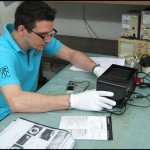You may have seen the term “Internet of Things” bandied about recently in the popular press and media outlets, and like many fads considered it to be some sort of “buzzword” or meaningless phrase created by social media gurus that can be safely ignored.
However nothing could be further than the truth. The IoT (as we will now refer to it) is a broad definition for how almost any device around us can be connected to each other and other services over the Internet.
That may sound a little broad, so let’s consider some examples:
- Checking the room temperature at home remotely, and control the HVAC if required – so you arrive home to a pleasant environment
- Monitoring and controlling water flow levels for irrigation systems in four different states from a central office
- Receiving an email from isolated vending machines when they detect possible theft, excess vibration or tilting
- Real-time position monitoring of valuable cargo shipments as they travel between warehouses
With fixed or reliable wireless Internet access in all these examples, you can accomplish it all and much more. The IoT allows you to be in more than one place at the same time – to receive data from anywhere – and to control from anywhere – as long as Internet access is available.
Furthermore the volume and types of data that can be collected is only limited by your requirements and device type. With a constant IP connection between a sensor and your IT system – data can be gathered for real-time analysis. Information is power – and the more you know about your assets and their performance – the more agile your decision-making can become.
This type of machine communication isn’t new – for example you’d be familiar with terms such as M2M and telematics for many years. However the concept of channelling all the data over the Internet or a private IP network is what the IoT is about.
Existing sensors and actuators (the devices that send and receive data) can usually be adapted to the new IoT with little effort. For example, a sensor with a 4-20mA current loop output can be engineered with a current sensor that can be read with a basic microcontroller – and then interfaced to the IoT node.
As most IoT environments are skewed towards the consumer and technically-literate hobbyist, there will be work involved in adapting the system for your particular needs. For example, the provider may offer a range of doorbell or simple temperature sensors – but not devices that can transmit or receive data over standard data buses such as IIC or SPI. In situations like these, your engineering team or parter will be required to create interfaces between your current devices and the bridge to the IoT.
Enabling your devices to work with the IoT can be a challenge, due to the variety of systems and standards on the market, each with their own pros and cons. There are many points to consider, and these can include:
The initial costs of interface hardware, staff training and ongoing maintenance
- Can you use your existing actuators and sensors – or create your own ones, or must you acquire new ones that are specific to the IoT system under consideration?
- Is the required power and communications infrastructure available when upgrading particular areas to the IoT?
- Will the data and commands be transferred using an external Internet-based host system, or can you keep the data within internal private networks?
- If using an external host system, can they offer you an agreed SLA value?
- Is the host system using proprietary data protocols – forcing you to use the host system provider’s engineering team to add your own devices to the system?
- What security features are available to stop unauthorised access to the devices and the host system?
The Internet of Things is more than an exciting concept – it exists today, and your organisation can benefit from it. However due to the incredibly combination of systems and options – consider partnering with an independent organisation that has your needs first and foremost.
Here at the LX Group we can discuss and understand your requirements and goals – then tailor anything from a modified sensor to a complete Internet-enabled system for you. For more information or a confidential discussion about your ideas and how we can help bring them to life – click here to contact us, or telephone 1800 810 124.
LX is an award-winning electronics design company based in Sydney, Australia. LX services include full turnkey design, electronics, hardware, software and firmware design. LX specialises in embedded systems and wireless technologies design. https://lx-group.com.au
Published by LX Pty Ltd for itself and the LX Group of companies, including LX Design House, LX Solutions and LX Consulting, LX Innovations.


